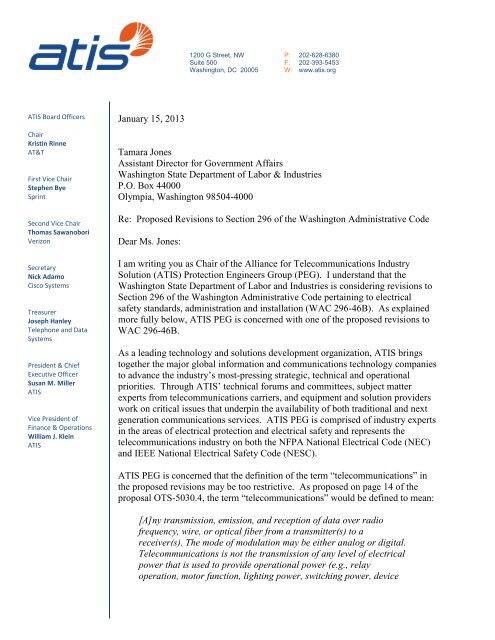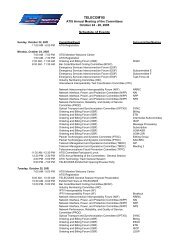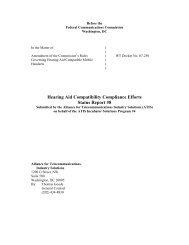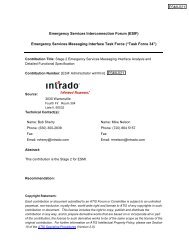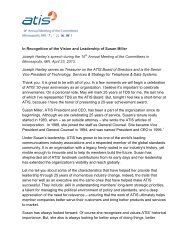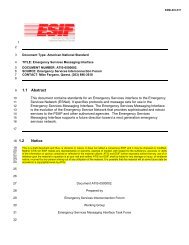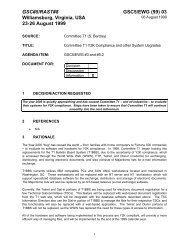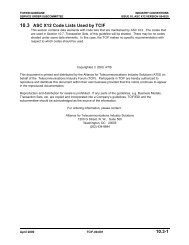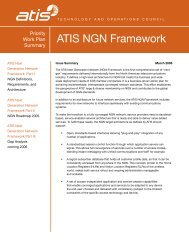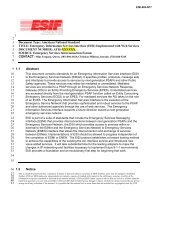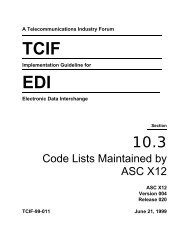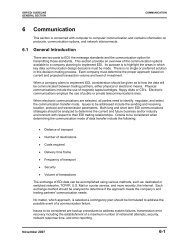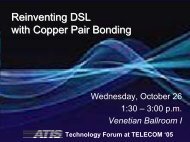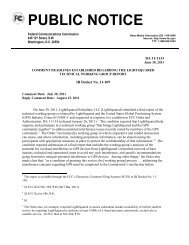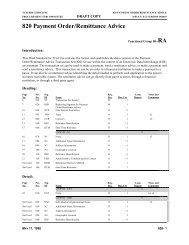Letter - ATIS
Letter - ATIS
Letter - ATIS
Create successful ePaper yourself
Turn your PDF publications into a flip-book with our unique Google optimized e-Paper software.
1200 G Street, NW P: 202-628-6380<br />
Suite 500 F: 202-393-5453<br />
Washington, DC 20005 W: www.atis.org<br />
<strong>ATIS</strong> Board Officers<br />
Chair<br />
Kristin Rinne<br />
AT&T<br />
First Vice Chair<br />
Stephen Bye<br />
Sprint<br />
Second Vice Chair<br />
Thomas Sawanobori<br />
Verizon<br />
Secretary<br />
Nick Adamo<br />
Cisco Systems<br />
Treasurer<br />
Joseph Hanley<br />
Telephone and Data<br />
Systems<br />
President & Chief<br />
Executive Officer<br />
Susan M. Miller<br />
<strong>ATIS</strong><br />
Vice President of<br />
Finance & Operations<br />
William J. Klein<br />
<strong>ATIS</strong><br />
January 15, 2013<br />
Tamara Jones<br />
Assistant Director for Government Affairs<br />
Washington State Department of Labor & Industries<br />
P.O. Box 44000<br />
Olympia, Washington 98504-4000<br />
Re: Proposed Revisions to Section 296 of the Washington Administrative Code<br />
Dear Ms. Jones:<br />
I am writing you as Chair of the Alliance for Telecommunications Industry<br />
Solution (<strong>ATIS</strong>) Protection Engineers Group (PEG). I understand that the<br />
Washington State Department of Labor and Industries is considering revisions to<br />
Section 296 of the Washington Administrative Code pertaining to electrical<br />
safety standards, administration and installation (WAC 296-46B). As explained<br />
more fully below, <strong>ATIS</strong> PEG is concerned with one of the proposed revisions to<br />
WAC 296-46B.<br />
As a leading technology and solutions development organization, <strong>ATIS</strong> brings<br />
together the major global information and communications technology companies<br />
to advance the industry’s most-pressing strategic, technical and operational<br />
priorities. Through <strong>ATIS</strong>’ technical forums and committees, subject matter<br />
experts from telecommunications carriers, and equipment and solution providers<br />
work on critical issues that underpin the availability of both traditional and next<br />
generation communications services. <strong>ATIS</strong> PEG is comprised of industry experts<br />
in the areas of electrical protection and electrical safety and represents the<br />
telecommunications industry on both the NFPA National Electrical Code (NEC)<br />
and IEEE National Electrical Safety Code (NESC).<br />
<strong>ATIS</strong> PEG is concerned that the definition of the term “telecommunications” in<br />
the proposed revisions may be too restrictive. As proposed on page 14 of the<br />
proposal OTS-5030.4, the term “telecommunications” would be defined to mean:<br />
[A]ny transmission, emission, and reception of data over radio<br />
frequency, wire, or optical fiber from a transmitter(s) to a<br />
receiver(s). The mode of modulation may be either analog or digital.<br />
Telecommunications is not the transmission of any level of electrical<br />
power that is used to provide operational power (e.g., relay<br />
operation, motor function, lighting power, switching power, device
<strong>Letter</strong> to T. Jones<br />
January 15, 2013<br />
Page 2 of 4<br />
power, etc.). If a circuit contains both operational power and<br />
telecommunications, the circuit is not telecommunications.<br />
<strong>ATIS</strong> PEG is concerned that this definition could be read to exclude many traditional<br />
telecommunications facilities, including T1 and HDSL repeater powering, FTTC/DSLAM linepowering,<br />
Power over Ethernet (PoE), and CATV repeater powering via coax. The definition<br />
could be read to even exclude old plain old telephone system (POTS) lines, which provide low<br />
voltage power to ring the phone and power the handset.<br />
As a result, the proposed rules would establish different and unnecessary requirements pertaining<br />
to, for example, the installation of most twisted pair (for traditional landline telecoms) and coax<br />
(for CATV companies) facilities than would be established for other telecommunications. These<br />
proposed new requirements are not needed for safety reasons as many of these low voltage and<br />
power-limited telecommunications facilities have been safely in use for decades (and in some<br />
cases more than a century). For example:<br />
<br />
<br />
<br />
In every twisted pair telecommunications circuit used for POTS (plain old telephone<br />
service), in addition to carrying the analog voiceband “telecommunications” signal, the<br />
twisted pairs also carry -48 VDC (typically less than 40 mA and 2 W) to power wired<br />
phones and wired handsets, and they periodically carry 88 VAC (typically no more than 20<br />
mA and 2 W) to ring some phones. Nominal 48 VDC is under the nominal 50 VDC limit<br />
classified by equipment Listed to UL 60950 as “Safety Extra Low Voltage”, and enjoys<br />
special exemptions in the NEC, and just about every electrical safety Code in the world<br />
(the some exemptions that vary by country, but range from anything under 75 VDC to<br />
anything under nominal 50 VDC) due to its very limited ability to cause harm to anyone.<br />
This type of “device-powering” on communications circuits has been in use for over 100<br />
years.<br />
T-1 carrier is still commonly in service (although newer 1.544 Mbps circuits will use<br />
HDSL), and there are tens of thousands of these circuits in existence. In addition to the<br />
B8ZS-encoded digital/analog signal carried on two twisted pairs, either -130 VDC or ±130<br />
VDC is also carried on the pairs to power the repeaters and the termination equipment.<br />
This power is typically no more than 30 mA and 8 W per pair, and has been safely used for<br />
more than half a century. It is governed by Article 830 of the NEC (part of the<br />
“Communications” chapter – Article 90.3 in the Code specifically states that Chapter 8<br />
stands alone unless it refers back to Chapters 1-7; and similar language is found in the<br />
proposed revisions to the WA rules, as noted previously in this letter.)<br />
HDSL is the modern equivalent of T-1, and among many other uses is the backhaul<br />
medium presently for almost all cellular phone calls. Almost every cell tower has<br />
multiples of HDSL lines to support taking the cellular call off the cell tower and onto the
<strong>Letter</strong> to T. Jones<br />
January 15, 2013<br />
Page 3 of 4<br />
<br />
<br />
<br />
public switched telephone network (PSTN). There are literally millions of these circuits in<br />
use. HDSL uses either a single pair or two pair, depending on the type of HDSL, and in<br />
addition to the analog “digital” hi-bit rate signal carrier waves, it too has repeaters, which<br />
are powered at -190 VDC. There might be as much as 100 mA on a pair (about 20 W).<br />
However, per Safety standards (including Telcordia NEBS GR-1089 Chapter 7, UL 60950-<br />
21, and NEC Article 830.15), each circuit is equipped with ground fault detection that<br />
limits the current to 10 mA (maximum of 2 W) when touched by a human, or any other<br />
fault condition occurs.<br />
Every coaxial CATV cable that travels more than a mile has repeaters that are powered by<br />
either 60 VAC or 90 VAC that travels on the center conductor and shield of the coax, while<br />
the signal travels in the space between the conductors. This is covered by Articles 820 and<br />
830 in the NEC, once again part of the “Communications” chapter.<br />
There are many FTTC (fiber to the cell) and DSL systems that are presently powered by<br />
“line-powering” at nominal -130 VDC, nominal ±130 VDC, or ±190 VDC, and many more<br />
systems under consideration for this type of line-powering. In some cases, the signal and<br />
the power ride the same pairs, and in some cases, they are separated. Either way, they are<br />
both specifically covered and defined as “communications circuits” by Article 830 in the<br />
NEC. The safety of these systems is governed by Article 830 in the NEC, Rule 224 in the<br />
NESC, Telcordia NEBS GR-1089 Chapter 7, and UL 60950-21. In sum, the power must<br />
be limited to 100 W, and ground fault detection limiting current to 10 mA must be<br />
provided for 190 VDC circuits.<br />
There are millions of PoE devices using nominal 48 V power according to IEEE 802.3af<br />
(15 W max, with the power being on the unused pairs in a Cat 5 ethernet cable) or 802.3at<br />
(30 W max, with the power being on both the unused pairs, and the signal pairs of a Cat 5e<br />
cable). The Safety Extra Low Voltage classification of nominal 48 V power has already<br />
been discussed.<br />
<strong>ATIS</strong> PEG understands that the nature of this rulemaking is to adopt the 2014 NEC. <strong>ATIS</strong> PEG is<br />
a member of the NEC Code Making Panel 1, which has responsibility for Article 100 of the NEC.<br />
It is <strong>ATIS</strong> PEG’s opinion that the proposed definition of telecommunications would be in direct<br />
conflict with the current version of the NEC. Moreover, it should be noted that the definition of<br />
“Communications Equipment” in Article 100 of the NEC is being clarified in the 2014 edition by<br />
the addition of a few words (underlined below) that will put the NEC and the proposed definition<br />
in even further conflict.<br />
Communications Equipment. The electronic equipment that performs the<br />
telecommunications operations for the transmission of audio, video, and data, and<br />
includes power equipment (e.g., dc converters, inverters, and batteries), technical
<strong>Letter</strong> to T. Jones<br />
January 15, 2013<br />
Page 4 of 4<br />
support equipment (e.g., computers) and conductors dedicated solely for the<br />
operation of the equipment.<br />
In addition, this proposed definition conflicts with the proposed new language at the beginning of<br />
Section 46B-800, which states that:<br />
Chapters 1 through 7, NEC, supplement and modify the requirements of chapter 8,<br />
NEC. If there are specific requirements or exceptions described in chapter 8, NEC,<br />
that are different from those in chapters 1 through 7, NEC, chapter 8 will prevail.<br />
In other words, the communications circuits (which specifically include line powering – see<br />
Article 830) described in Chapter 8 of the Code are not generally covered by the rest of the Code.<br />
In sum, “device powering” over telecommunications lines has been around for over 100 years.<br />
Such device powering is extremely widespread and is very safe due to voltage, current, and power<br />
limitations imposed by various safety standards. Further regulation by the addition of the language<br />
that excludes cables carrying “device power” from being classified as telecommunications circuits<br />
is highly unnecessary and costly. <strong>ATIS</strong> PEG therefore recommends that the proposed definition of<br />
“telecommunications” be deleted, or modified to allow minimal power-carrying by<br />
telecommunications lines, as allowed presently by the NEC and many other codes and standards.<br />
We would be happy to discuss this further with you. If you have any questions, please feel free to<br />
contact the undersigned at egallo@telcordia.com or via telephone at (732) 699-3312.<br />
Regards,<br />
Ernie Gallo<br />
<strong>ATIS</strong> PEG Chair<br />
Cc: Thomas Goode, <strong>ATIS</strong> General Counsel


